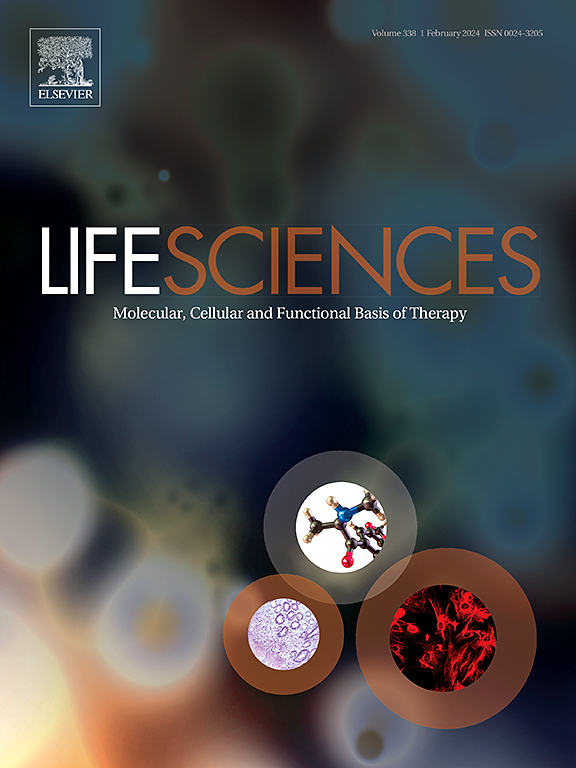激光产生的单线态氧对β -淀粉样蛋白神经毒性具有保护作用
IF 5.1
2区 医学
Q1 MEDICINE, RESEARCH & EXPERIMENTAL
引用次数: 0
摘要
β-淀粉样蛋白是在阿尔茨海默病中形成细胞外老年斑的肽。β-淀粉样蛋白与遗传形式的阿尔茨海默病和聚集肽的神经毒性的联系已被认为是β-淀粉样蛋白参与这种毁灭性疾病的病理机制。β-淀粉样蛋白聚集的毒性是由钙信号、线粒体能量代谢和氧化应激的变化引起的。激光(1267 nm)诱导的单线态氧被证明能够修饰蛋白质和加速能量代谢,这可能会改变β-淀粉样蛋白的作用。通过神经元和星形胶质细胞的原代共培养,研究了激光产生的单线态氧对β-淀粉样蛋白诱导的钙信号、线粒体能量代谢和氧化应激的影响。我们发现单线态氧可以阻止全肽β a1 - 42的聚集,降低β-淀粉样蛋白对细胞质和线粒体钙升高的影响,减少线粒体去极化和线粒体NADH的消耗。其结果是保护神经元和星形胶质细胞免受β-淀粉样蛋白诱导的细胞死亡。因此,单线态氧可能具有神经保护作用。本文章由计算机程序翻译,如有差异,请以英文原文为准。
Laser-generated singlet oxygen is protective against beta-amyloid neurotoxicity
β-Amyloid is the peptide which forms extracellular senile plaques in Alzheimer's disease. Link of the β-amyloid to inherited form of Alzheimer's disease and neurotoxicity of aggregated peptide has been suggested to the involvement of β-amyloid in the mechanism of pathology of this devastating disease. The toxicity of aggregated β-amyloid is triggered by changes in calcium signal, mitochondrial energy metabolism and oxidative stress. Laser (1267 nm)-induced singlet oxygen is shown to be able to modify proteins and accelerate energy metabolism that potentially may modify the effects of β-amyloid. Using primary co-culture of neurons and astrocytes we studied the effect of laser-generated singlet oxygen on β-amyloid-induced calcium signal, mitochondrial energy metabolism and oxidative stress. We have found that singlet oxygen prevents aggregation of the full peptide βA 1–42, reduces the effect of β-amyloid on cytosolic and mitochondrial calcium elevation, reduces mitochondrial depolarization and depletion of NADH in mitochondria. As result it protected neurons and astrocytes against β-amyloid-induced cell death. Thus, singlet oxygen could play neuroprotective role.
求助全文
通过发布文献求助,成功后即可免费获取论文全文。
去求助
来源期刊

Life sciences
医学-药学
CiteScore
12.20
自引率
1.60%
发文量
841
审稿时长
6 months
期刊介绍:
Life Sciences is an international journal publishing articles that emphasize the molecular, cellular, and functional basis of therapy. The journal emphasizes the understanding of mechanism that is relevant to all aspects of human disease and translation to patients. All articles are rigorously reviewed.
The Journal favors publication of full-length papers where modern scientific technologies are used to explain molecular, cellular and physiological mechanisms. Articles that merely report observations are rarely accepted. Recommendations from the Declaration of Helsinki or NIH guidelines for care and use of laboratory animals must be adhered to. Articles should be written at a level accessible to readers who are non-specialists in the topic of the article themselves, but who are interested in the research. The Journal welcomes reviews on topics of wide interest to investigators in the life sciences. We particularly encourage submission of brief, focused reviews containing high-quality artwork and require the use of mechanistic summary diagrams.
 求助内容:
求助内容: 应助结果提醒方式:
应助结果提醒方式:


